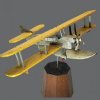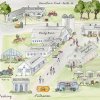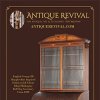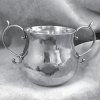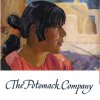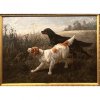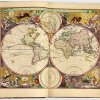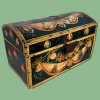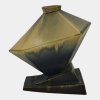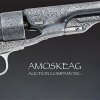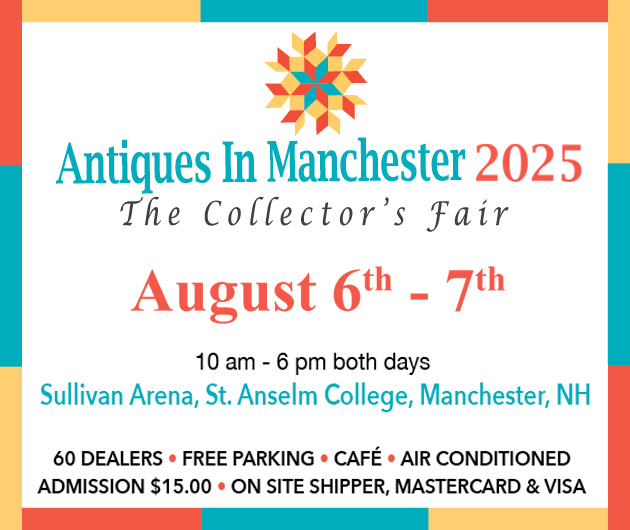Variety Characterizes Quinn's Fall Auction
September 16th, 2017
Quinn’s Auction Galleries, Falls Church, Virginia
Photos courtesy Quinn’s Auction Galleries
Quinn’s Auction Galleries held its fall cataloged sale of fine and decorative arts at its Falls Church, Virginia, galleries on September 16. The auction combined consignments from its central Virginia location in Louisa with a wide array of offerings already prepared for sale at the northern Virginia headquarters in Falls Church.
The high lot of the sale came from within the jewelry category. It was a platinum ring with a solitaire diamond flanked by baguette diamonds, and it sold for $14,400 (including buyer’s premium), below its estimate.
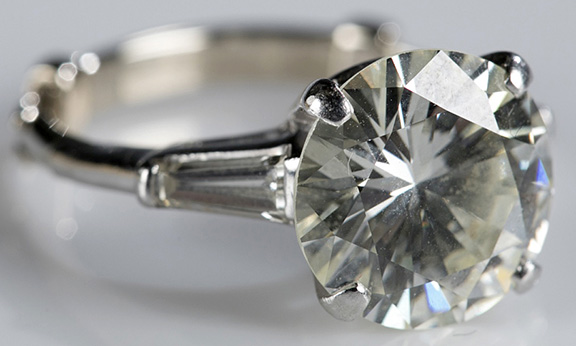
This diamond and platinum ring was the clear leader among the jewelry lots. The center stone, a 4.83-carat round brilliant-cut diamond, is flanked by two small baguette-cut diamonds. A telephone bidder won the ring at $14,400 (est. $16,000/20,000).
The high lot from among the more traditional fine and decorative arts offerings was a beautiful circa 1900 gilt and enameled bronze sculpture, Butterfly Dancer, by Louis Chalon (French, 1866-1940). A closeup of the figure graced the cover of the auction catalog, and the bronze sold for $11,400, above its estimate. Chalon is noted for his finely detailed small bronzes, and his imaginative designs were part of the Art Nouveau movement of the late 19th and early 20th centuries. This figure was created around the time of the 1900 Éxposition Universelle in Paris, which brought the already established Art Nouveau style to a worldwide audience and is considered to be the signature event celebrating this art form.

Pictured here is one of the auction’s more intriguing lots, a circa 1900 Art Nouveau bronze sculpture of a nude female with large butterfly wings that is attributed to Louis Chalon (French, 1866-1940). The figure stands on a sunflower blossom that is set on an octagonal marble base, and she and her wings are gilt and accented with blue and peach enamel. The sculpture bears only the Paris foundry mark of Paul Louchet (French, 1854-1936), an artist, sculptor, and gilder who is known to have collaborated with his friend Louis Chalon. Butterfly Dancer, 16½" high, sold for $11,400 (est. $6000/8000).
Furniture continued its hit-and-miss performance of the recent past. In addition to the lots shown among the photos, several other pieces are worthy of note. A handsome mid-19th-century walnut and yellow pine Empire chest of drawers with highly figured drawer faces and carved columns brought $1140 (est. $300/500). A 19th-century English demilune Hepplewhite sideboard with burled walnut veneer and satinwood inlay on a mahogany frame sold for $1320 (est. $1000/2000). Unfortunately, a very interesting late 19th-century punched-tin food safe in pine, displaying a definite Eastlake style and bearing a Lexington, Virginia, retailer’s label, failed to generate any bids (est. $600/900).
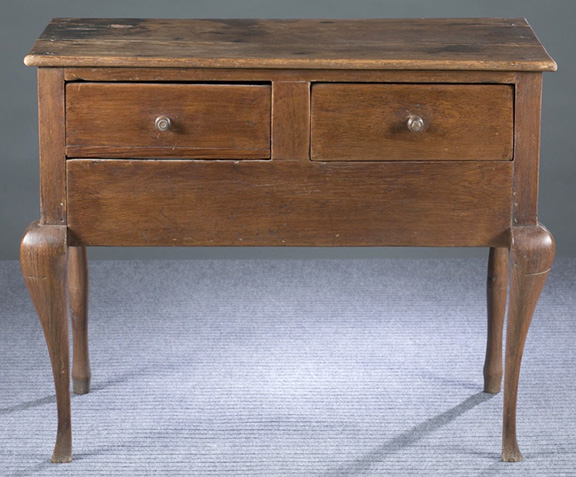
Cataloged as a walnut and yellow pine Shenandoah Valley server with mixed secondary woods, this lot drew the attention of several furniture sleuths. There was no consensus as to how the server began its life, but most agreed that it is likely the bottom section of a larger piece.
 The case features a two-board walnut top, with two drawers below, and the side skirt boards are nicely scalloped (the front skirt board is likely a replacement). The front cabriole legs have pronounced knees that transition to very slender legs and terminate in feet that hint at a Spanish or trifid carving; the back legs are straight and turned. The internal frame construction suggests that there were likely three small drawers below the upper set.
The case features a two-board walnut top, with two drawers below, and the side skirt boards are nicely scalloped (the front skirt board is likely a replacement). The front cabriole legs have pronounced knees that transition to very slender legs and terminate in feet that hint at a Spanish or trifid carving; the back legs are straight and turned. The internal frame construction suggests that there were likely three small drawers below the upper set.
Perhaps this was a backcountry cabinetmaker’s interpretation of a formal piece. Whatever its original purpose, the 32¾" x 40" x 20½" server sold for $780 (est. $400/600).
In addition to the expected mix of categories from multiple consignors, Quinn’s offered a run of nearly 100 lots from the estate of John Woodall, a northern California performance artist who immersed himself in ethnographic and cultural collecting. Portions of his collections have appeared in previous sales at Quinn’s, and this group was part of his militaria collection.
The lots consisted primarily of multiple-item groupings of senninbari, thousand-stitch belts or sashes, vests, and prayer cloths, plus 25 yosegaki (good luck flag) textiles featuring the familiar Rising Sun emblem. These are very personal mementos given to soldiers headed to war as a show of support, faith, and good luck from friends and family, and they dated from the Russo-Japanese War (1904-05) through World War II.

This lot consists of six small Japanese bronze okimono, or objects of display, that date from the late 19th and early 20th centuries. They depict various mythical beasts and guardians. The largest stands 3¼" high, and four of the figures rest on custom-carved wooden bases. Estimated at $200/300, the group sold for $9000.
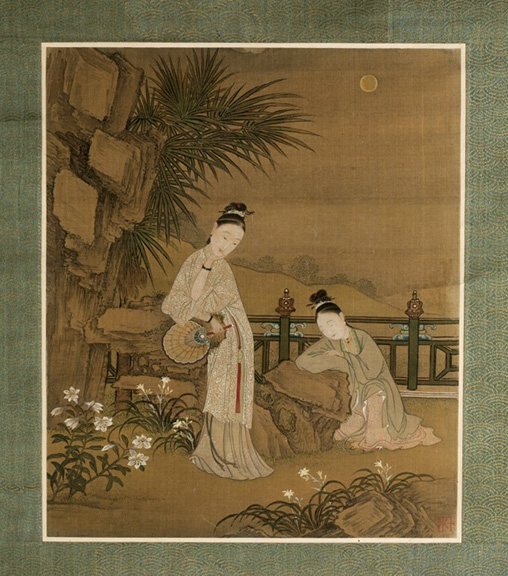
This 20" x 15" ink and color on silk painting of two Chinese female figures dates from the late 19th or early 20th century and is executed in the manner of Qiu Ying (Chinese, 1494-1552). The Chinese painting had been attached to a later Japanese scroll mounting, and this bicultural artwork sold for $2520 (est. $500/700).
Many senninbari and yosegaki were taken as souvenirs during World War II, and efforts are being made to return as many of those items as possible to the families or home communities of the soldiers who likely lost their lives in the Pacific theater. The Obon Society, an international not-for-profit organization based in Astoria, Oregon, is deeply involved in that effort.
For additional information, contact Quinn’s Auction Galleries at (703) 532-5632; website (www.quinnsauction.com).
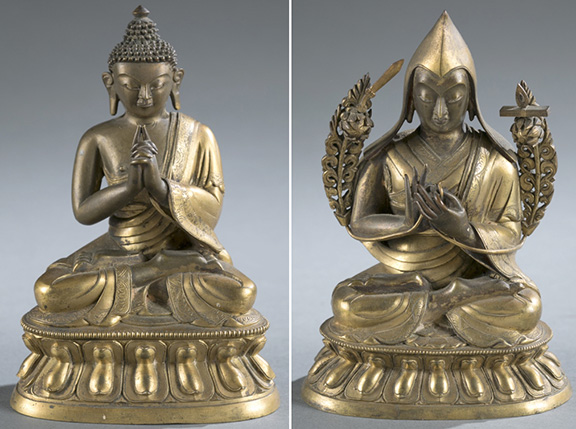
These 18th-century gilt-bronze Tibetan Buddhist figures appear to be very similar. Each is seated in the lotus position on a raised throne, and each is marked under the base with the same decorative engraving.
The 6¾" high figure on the left depicts Shakyamuni, the historic Buddha figure, with his hands in the mudra, or ritual gesture, of enlightenment. The 7" high figure on the right depicts Tsongkhapa (1357-1419), a famous teacher of Tibetan Buddhism, with his hands in a teaching mudra. Each figure sold to a different Internet bidder. That of Shakyamuni brought $9600 (est. $2000/3000), and that of Tsongkhapa sold for $9000 (est. $2000/3000).
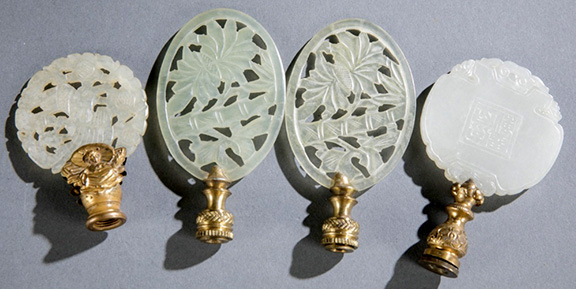
This group of four carved lamp finials proved to be something of a surprise. They display carved and openwork floral pattern designs. Three are of serpentine, the solid example is of jade, and all are fitted to a threaded base. Estimated at $100/200, the foursome brought $2760.

The dial of this 89¼" high cherry tall-case clock identifies the maker as Benjamin Willard (1743-1803), the first member of the famous clockmaker family to set up in the business; he was followed by three of his brothers. The clock face features a double moon-phase dial with nautical and landscape scenes alternating as the dial rotates. Roman numerals indicate the hours, and Arabic numerals the minutes. The spandrels are decorated with cherubs and a crown, and “Benj Willard / Roxbury” is engraved on the face. The domed hood has an eagle-on-globe finial, and below is a thin cornice with dentil molding. The hood door is arched and flanked by fluted columns. The waist section features a tombstone door and extensive horizontal grain veneer on the chamfered corners and door stiles, and the base is raised on bracket feet. It sold to an Internet bidder for $4800 (est. $2000/3000).
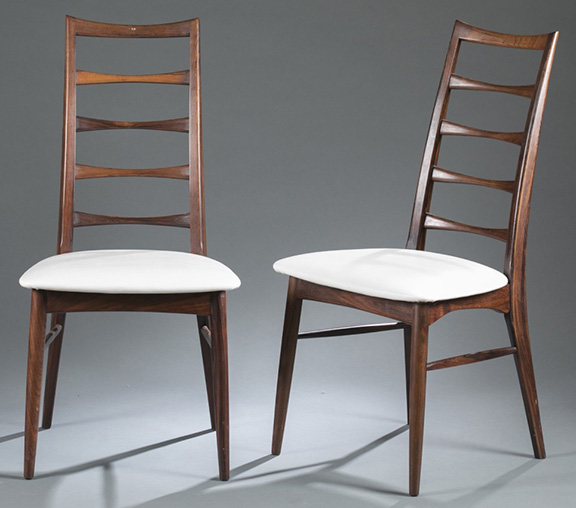
One of the auction’s mid-20th-century offerings was a set of six 37½" high rosewood Lis design ladder-back chairs (two shown) by the Danish firm Niels Koefoed. The Lis design was introduced in 1961, and the seats on this set are of white vinyl. The set sold for $1560 (est. $800/1200).
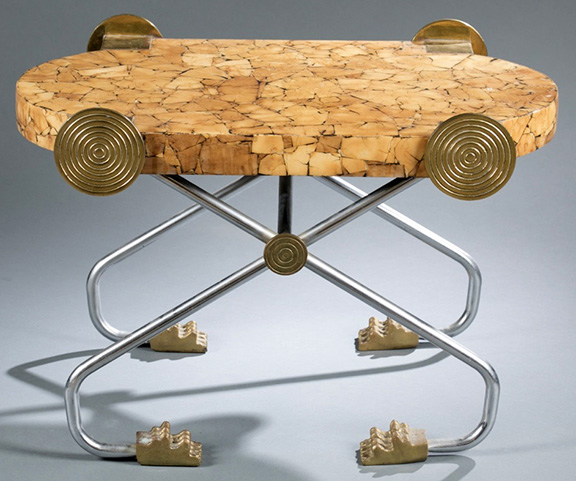
This 19" x 28" x 18¾" Modernist side table by Colombian artist/designer Enrique Garcel dates from the 1970s or 1980s and features a bent tubular “X” frame with brass mounts. Although Garcel is noted for his use of bone and horn veneers, the table has a lacquered surface covered with a material that simulates the look of cork. It sold for $1080 (est. $200/300).
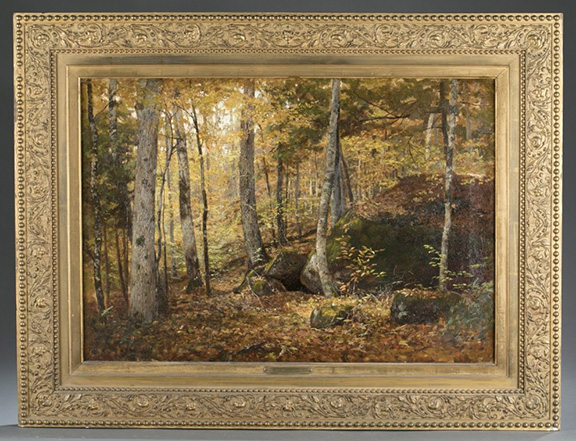
This 14" x 22" (sight size) signed oil on canvas by Roswell Morse Shurtleff (1838-1915) depicts a tranquil forest scene in the Keene Valley of New York’s Adirondack Mountains. Offered in its original frame, the painting sold to an absentee bidder for $2196 (est. $1500/1800).
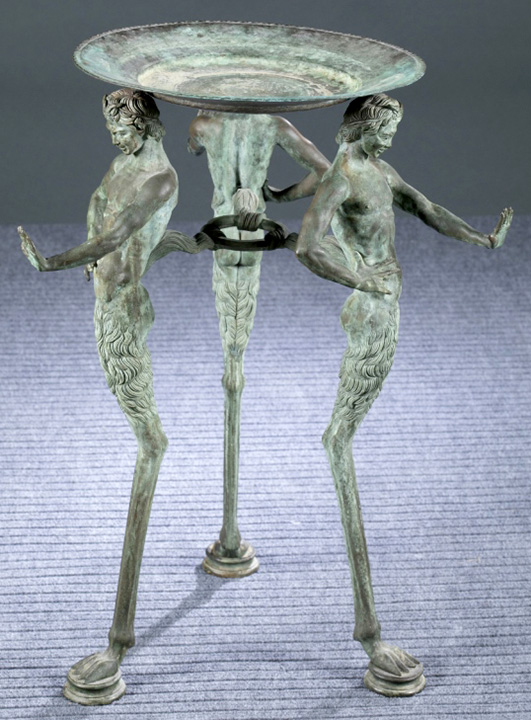
This 29¼" high x 23" diameter copper plant stand is supported by three cast Pan-form figures, each of which is posed with one hand on his hip and the other arm outstretched with the palm facing out. The hotly contested stand ultimately sold for $2400 (est. $300/500) to an Internet bidder.
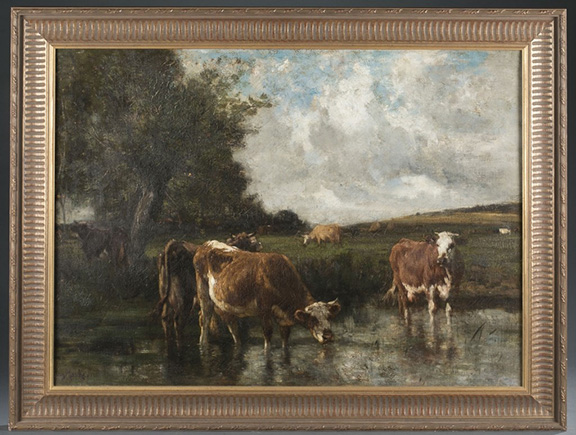
This signed oil on canvas pastoral landscape by Émile van Marcke (French, 1827-1890) depicts a small herd of cattle drinking at water’s edge. Measuring 23" x 30¾" (sight size), it sold for $5400 (est. $4000/6000).
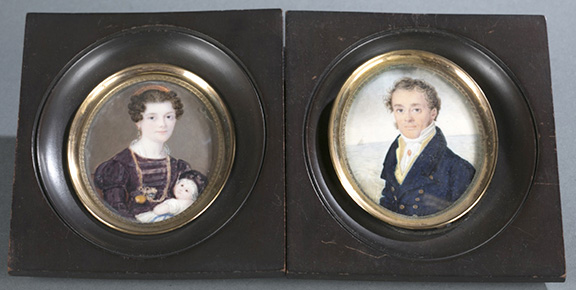
The catalog identifies the subjects of this pair of early 19th-century oil on ivory portrait miniatures as Assa and Mary Jane Casper. Each measures 3¾" x 3" (sight size) and is set within an ebonized frame. The woman holds a child, and her likeness is signed “Fribourg.” The man wears a military-style jacket and is shown against a seascape with a sailing vessel in the distance; his likeness is unsigned. The miniatures sold for $2040 (est. $200/400).
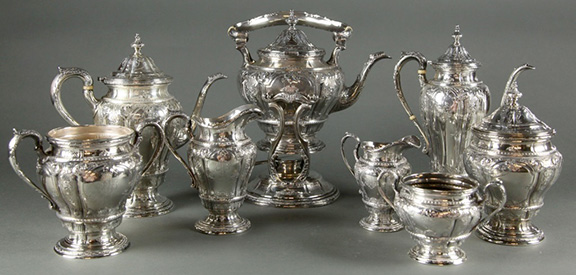
This eight-piece repoussé sterling silver tea and coffee service by Dominick & Haff (1889-1928) of New York City consists of a coffeepot, a 10 7/8" high teapot, a hot water pot with heating stand, two creamers, a sugar bowl, and a waste bowl. All are decorated in a floral motif, marked “Sterling,” and display Dominick & Haff’s mark, and the coffeepot and teapot have ivory insulators. The set sold for $3250 (est. $4000/6000) to an Internet bidder.
Originally published in the November 2017 issue of Maine Antique Digest. © 2017 Maine Antique Digest

